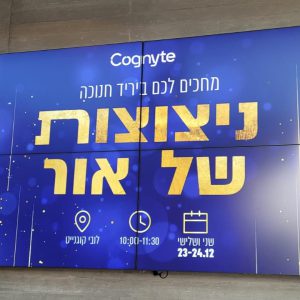A case study by Eli Amar, ProMarketing Wizard’s CEO
After holding three virtual events for DVN (Driving Vision News), we received a new challenge – holding their annual conference in Shanghai, China.
DVN is your one-stop source of the information you need to keep up with all the important events and innovations happening in the Lighting, driver assistance systems, and car interiors industries
The Shanghai conference theme was “High Tech Lighting, Impact on Safety and Regulation”, and it brought together around 350 worldwide participants involved in lighting and ADAS: directors, managers, and experts, among which 240 were present in person in Shanghai and the rest of them online.
At a glance, the event sounded easy enough, but then we looked it over and found some technical and operational difficulties. As presented to us by Salomon Berner, VP of BUSINESS DEVELOPMENT at DVN, the main challenge was to set up a 2-day event at the Sheraton hotel in Shanghai and broadcast it on Expo Wizard as well.
The Main Challenges
We had several topics we needed to sort through, and we had three weeks to plan and execute everything.
The First Challenge – Everything Was Managed Remotely
Going to China in person wasn’t possible, so we needed to find a top-notch Chinese team to manage the event onsite while broadcasting simultaneously to the Expo Wizard’s platform.
The Second Challenge – One Event, Two Languages
This event was meant to be broadcast in two languages simultaneously when the content in Chinese was to be translated to English, and vice versa, with the help of live translators.
The Third Challenge – Travel Restrictions in China
Due to travel restrictions, we had to find a broadcast solution for our Chinese attendees. As western sites such as Vimeo and YouTube aren’t available in China, this was no easy feat.
The Fourth Challenge – Scheduling Off-site Speakers
Most of the event speakers were located in Europe, and we had to make sure they could go live with a high-quality connection and improved video options so that when we showcased them on large screens onsite, their images would look sharp.
The Fifth Challenge – Live Panels
At the end of each session, the speakers onsite and the speakers located at their homes were to answer questions asked by the participants at the actual hall and at home (their questions were submitted in writing), whilst simultaneously translating everything in real-time, without interrupting the dynamic between all the speakers on stage.
The Sixth Challenge – The Time Difference
It’s important to note that the event was held at 8 am Shanghai time, which means it went live at 2 am Europe time.

How We Overcome All These Challenges
We needed a detailed plan to manage the event on multiple levels:
- First, Holding a full event onsite, including meals, coffee breaks, name tags, venue design, gifts, AV, and live translations.
- Second, scheduling the agenda with all the relevant speakers, those at the hotel and the ones speaking from home, and pre-recording some of the content.
- Managing an international large-scale virtual event on Expo wizard, for all the remote participants.
As the project manager, I took it upon myself to manage the virtual event, and as a technological partner, I took the most professional person I know, with whom we have had over twenty virtual broadcasts and events, Shai Camerini, the CEO of Cutaway.
Due to the challenges presented, the first thing that I realized was that it all depends on having a reliable onsite vendor to manage all the activity in the studio. Therefore we had to find a third, English-speaking Chinese partner who understands our technical plan.
Fortunately, we found Jimmy, who learned English from watching American movies via satellite. He understood our needs and translated them to the Chinese operations team. Since WhatsApp does not work in China, we had to use WeChat to communicate fluently with the Chinese team.
The most frustrating part about the preparations for the event was finding tech solutions for live broadcasting and for post-event VOD rewatching, since sites we are experienced with, like YouTube and Vimeo, are blocked in China, even with a VPN.
We had many different attempts with Chinese providers that worked sporadically – and that was too big of a risk for us. We also had difficulty gaining access to Chinese websites, understanding the lingo, translating, and receiving support in English. In addition, the fees these providers were charging were relatively high.
The solution we ended up using was found by Jimmy, using a double streaming service. On the one hand, streaming via RMTP for viewers outside China, and on the other streaming to the Chinese platform VZAN, which we could then embed within our website.
The next challenge was to create a detailed line-up of all broadcasts. Due to our experience, we offered to use code names for each portion so that everybody could easily communicate which portion we were talking about. Each item in the line-up had a starting time, end time, someone to present the speaker, a link to a short description of the speaker, and a link to the talk or to a slide show, that was either pre-recorded or broadcast live.
The talks were remotely recorded by Cutaway, and it quickly became clear that the most efficient and organized way to share content between all organizing parties was via Dropbox. Even the opening words of every session were pre-recorded as a backup for the live broadcast by the sessions’ chairperson.
Additionally, we created three Zoom channels, one for broadcasts, a second for communication between the team members and for observing the main hall, and a third for backup.
Fortunately, on the first day, we had an opportunity to run a preliminary rehearsal, before the general rehearsal in the main hall. That is how we found out that the Chinese team was not entirely clear on all aspects of the operation, specifically regarding the VZAN broadcast.
After the general rehearsal, Salomon Berner’s message was clear: no matter what happens in the online broadcasts – in the main hall the event sticks to the schedule, and if the live streaming of a session does not run smoothly, then we use the pre-recorded feed.
The truth is we almost had to use some of the pre-recorded footage: It wasn’t until 7:00 a.m. China time, one hour before the event starts off, that the main hall was powered, and we could boot up our systems. 30 minutes before the broadcasts begin, at 2:30 a.m. Israel time, we realized that the Chinese team could not join the zoom, not even via VPN.
We all joined the effort, and Shai Camerini, calmly and efficiently, instructed the Chinese team how to change the settings on their Apple computers to bypass the blocks, so only 5 minutes before the event begins we managed to go live. From that point on the entire event went smoothly.
Matan from our team, Talia from the Cutaway team, the French DVN team, and Jimmy’s team in Shanghai, conducted the event for 2 days straight – and we all shared a sigh of relief and great satisfaction when the event closed, and the broadcasts were over.
At this point, Solomon told me that he had a dream and that we made it come true. He was expecting problems, but everything went smoothly. This event was a success due to the combination of vision and clear instructions, highly technical and professional teams at Cutaway, with Jimmy, and here in Expo Wizard, and finally a great persistence to not give up and look for optimal solutions until we succeed.
Do you have a virtual or hybrid event taking place in China? We will be happy to help you plan it!

